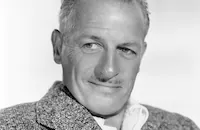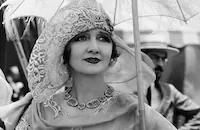The Barbarian

Brief Synopsis
Cast & Crew
Sam Wood
Ramon Novarro
Myrna Loy
Reginald Denny
Louise Closser Hale
C. Aubrey Smith
Film Details
Technical Specs

Synopsis
When Jamil El Shehab, a handsome, opportunistic Egyptian dragoman, spies Diana Standing, a beautiful half-English, half-Egyptian socialite, at the Cairo train station, he is determined to become her official guide and driver. Using Diana's dog Missy as bait, Jamil maneuvers himself into the job over the objections of her pompous English fiancé, businessman Gerald Hume. Then, as she dines and tours the Pyramids, Jamil tricks Gerald into leaving Diana and woos her with love songs and pretty flattery. Also vying for Diana's attention is Pasha Achmed, Gerald's unscrupulous Egyptian business partner. To be alone with Diana, Pasha arranges for Gerald to be sent on a phony mission to the aqueduct project he and Gerald are building in the desert. Aware of Pasha's scheming, Jamil blackmails his countryman and uses his servant position to work his way into Diana's hotel bedroom. After Jamil kisses her in a moment of bold passion, however, Diana dismisses him and starts on a caravan for Gerald. During the journey through the desert, Jamil appears and forcefully replaces Diana's guide. Once again, Diana falls under the spell of Jamil's romantic singing and finds herself in his arms. Outraged by his embraces, Diana strikes Jamil with a whip and orders the caravan to return immediately to Cairo. On the way back, however, Jamil sends Powers, Diana's chaperone, and the rest of the caravan on one route, while conniving to get Diana to Pasha's oasis retreat via another. At the oasis, Diana receives royal treatment until Pasha, on word from Jamil that Diana went to his place deliberately, attacks her. After Diana screams for Jamil to save her from Pasha, Jamil abducts her from his rival's house during the night. In the desert the next day, Pasha's henchmen threaten to reclaim Diana but are killed by Jamil. With only one horse between them, Jamil forces Diana to walk behind him as they continue their trek, then prevents her from drinking from a desert pond until both the horse and he have drunk. Defeated by thirst, hunger and humiliation, Diana gives in to Jamil's forced advances that night and allows him to take her to his tribal village the next day. There Jamil reveals that he is actually a sheik who chose to work as a dragoman as part of his royal training. Although Diana passively agrees to become Jamil's wife, she tosses the ceremonial water in his face during the wedding and humiliates him in front of his father and his tribe. Devastated by Diana's actions, Jamil allows her to return to Cairo, where she immediately proceeds with her marriage to Gerald. Moments before she is to wed Gerald, however, Diana is visted by Jamil, now a fugitive from the Egyptian army. When Jamil begins to sing his love song, Diana realizes that she truly loves him and abandons Gerald at the altar. As they float down the Nile together, Diana confesses her parentage to Jamil, who tells her that he would love her even if her mother was Chinese.

Director

Sam Wood
Cast

Ramon Novarro

Myrna Loy

Reginald Denny
Louise Closser Hale

C. Aubrey Smith

Edward Arnold
Blanche Friderici
Marcelle Corday

Hedda Hopper
Leni Stengel

Akim Tamiroff
Crew
Adrian
James Brock
Nacio Herb Brown
Arthur Freed
Cedric Gibbons
Elmer Harris
Tom Held
Bernard H. Hyman
Anita Loos
Harry Parkins
Oscar Radin
Harold Rosson
Edgar Selwyn
Douglas Shearer
Herbert Stothart
John Waters
Lester White
Sam Wood

Photo Collections
Videos
Movie Clip


Film Details
Technical Specs

Articles
The Barbarian
The Barbarian was a sound remake of Novarro's own 1924 silent film The Arab, based on Edgar Selwyn's play of the same name, in which he had starred with Alice Terry. For the 1933 version, screenwriter Frances Goodrich and her husband, Albert Hackett, worked on the assignment for a few days before giving up. Goodrich told her agent that that story was old-fashioned. American tourist Diana (Loy) goes to Cairo with her aunt and uncle (Louise Closser Hale and C. Aubrey Smith) on a tour and to meet her fiancé (Reginald Denny). While there, she encounters Jamil (Novarro), who acts as a tourist guide and falls in love with him, not knowing he's really a prince. To avoid trouble with the censors over having a Caucasian and an Arab in a relationship, it's later revealed that Diana has some Egyptian blood. It sounds ridiculous now and it was ridiculous then to Goodrich, who complained that "It was all so false, all hooey." There was certainly more than a passing resemblance to an old Rudolph Valentino "sheik" film, but Valentino had been in his grave for seven years and sheiks were passé in the age of Clark Gable and The Great Depression. Anita Loos and Elmer Harris took over the screenplay from Goodrich and Hackett.
The working title of the 1933 film was Man of the Nile, but was later changed to The Barbarian. It went into production on the MGM lot in February 1933, with location shooting done in Yuma, Arizona. The cast and crew, which included director Sam Wood, were shooting on the studio back lot on March 10, 1933, when the Long Beach Earthquake struck. Measuring 6.4 on the Richter scale, the quake caused considerable damage and rattled nerves. The Barbarian was shut down for the day when the arc lamps that lit the set fell over and the palm trees followed suit. Less dramatic but shocking enough to cause the censors to get involved was Loy's supposed "nude" swimming scene. Existing stills do make it seem as though Loy was naked under the water, but she admitted in her autobiography that she was actually wearing a flesh colored bodysuit. Nevertheless, the censors demanded that "all shots in which the girl's body is visible through the water" be cut. While The Barbarian made a $100,000 profit for the studio, it was considered racy enough to be banned from rerelease after the 1934 adoption of the film censorship rules known as The Production Code.
Loy and Novarro got along splendidly during shooting and after filming was over, Novarro had Myrna Loy house-sit for him at his home in Los Feliz, while he was on a singing tour in Europe. While he was gone, Myrna Loy read an article that claimed that Novarro, who was "heretofore impervious to women," had fallen madly in love with Loy and she with him. Loy, who was really dating producer Arthur Hornblow (they would later marry), was furious and ran down to the studio where she made sure Howard Strickling and his publicity department would never pair her with a costar in the gossip columns again. She later said, "It was preposterous. Ramon wasn't even interested in the ladies and I was seeing Arthur exclusively, so the publicity department had chosen a most unlikely pair."
Producer: Sam Wood
Director: Sam Wood
Screenplay: Elmer Harris, Anita Loos (writers); Edgar Selwyn (play)
Cinematography: Harold Rosson
Art Direction: Cedric Gibbons
Music: Herbert Stothart
Film Editing: Tom Held
Cast: Ramon Novarro (Jamil El Shehab), Myrna Loy (Diana 'Di' Standing), Reginald Denny (Gerald Hume, Diana's Fiancé), Louise Closser Hale (Powers), C. Aubrey Smith (Cecil Harwood), Edward Arnold (Achmed Pasha), Blanche Friderici (Mrs. Hume, Gerald's Mother), Marcelle Corday (Marthe, Diana's Maid), Hedda Hopper (Mrs. Loway, American Tourist), Leni Stengel (Ilsa, German Tourist).
BW-83m.
by Lorraine LoBianco
SOURCES:
Ellenberger, Allan R. Ramon Novarro: A Biography of the Silent Film Idol, 1899-1968: With a filmography
Leider, Emily W. Myrna Loy: The Only Good Girl in Hollywood
Motion Picture Herald Volume 112
Soares, André and Slide, Anthony Beyond Paradise: The Life of Ramon Novarro

The Barbarian
Quotes
Trivia
Myrna Loy wrote in her autobiography that she was wearing a flesh-tinted body suit in the supposed nude scene.
Notes
The working title of this film was Man on the Nile. According to Myrna Loy's autobiography, some scenes for the film were shot in Yuma, AZ. Loy also notes that, during a scene in which she takes a rose petal bath, she was wearing a flesh-toned bodysuit. Although the script of this film is notably different from Jesse L. Lasky's 1915 silent, The Arab, which was directed by Cecil B. DeMille, Edgar Selwyn authored both films and used some of the same material in both productions (see AFI Catalog of Feature Films, 1911-20; F1.0133). In addition, M-G-M's 1924 remake of the 1915 film, which is also called The Arab, bears some resemblance to the 1933 picture. The Barbarian, however, is not a remake of these earlier pictures. Rex Ingram directed and Ramon Novarro and Alice Terry starred in the later silent film (see AFI Catalog of Feature Films, 1921-30; F2.0157).














